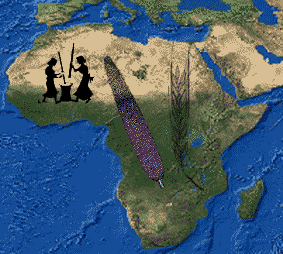|

|
 |

The Fifth International Workshop for African Archaeobotany will
be held 2-5 July, 2006
at the Institute of Archaeology,
University College London. For scheduled papers and absracts select days below.
|
The Fifth International Workshop for African Archaeobotany will
be held 2-5 July, 2006 |
|
|
Wednesday, 5 July, 2006 Session: Archaeobotany and political economy--
Back to the Fayum: Roman and Neolithic sites in Egypt revisited
Mans Schepers University of Groningen
This presentation will deal with some preliminary archaeobotanical results of the Fayum project (Egypt), a combined project of the University of California Los Angeles (UCLA) and the Rijksuniversiteit Groningen (RuG). The Neolithic period Between 1926 and 1929 the Fayum was extensively studied by Caton-Thompson and Gardner, the results being published in The Desert Fayum (1934). The UCLA/RuG project started a survey in the area in 2004 to relocate these sites and to look for yet unknown sites. One of the sites successfully relocated was the Upper K pits site. It turned out that the previous inventory was not complete. The new K pits provide us with an excellent opportunity to study the early technique of food storage. The basketry will be studied by Willeke Wendrich and will be no subject of this lecture. Our research focuses both on the filling of the pits, and on the ‘lids’ used to cover the pits. Unfortunately, no grain-filled pits were found, so the samples of the filling consist mostly of blown in desert sand. Most of the determinable grain fragments are loose finds, recovered while sweeping the bottom of the basket. We assume that only the botanical remains found in direct association with the basketry are valuable, whereas the few plant remains in the sand blown material are considered to be contaminated. In this way, the original content can be determined even by a small number of remains. Another reliable data source was found in the lids covering the pits. Dissolved fragments of these concrete-like lids contained grain fragments, whose preservations was clearly distinct from the remains found in connection with the basketry. Special attention will be paid to the fairly narrow rachis fragments of the Hordeum vulgare ssp. vulgare. The Roman period Another part of the research was carried out in Karanis, located in nowadays Kôm Aushim. Parts of this town have been excavated by the University of Michigan in the period between 1925 and 1935. Although substantial amounts of subfossil remains have been sampled, no serious study of these remains have been carried out. The aim of the new research is twofold. On one hand, a more balanced picture of the economic plants will be produced. This will be done by studying the botanical remains secured by the previous excavations, currently stored at the Agricultural Museum (Dokki, Cairo) and the Kelsey Museum (Michigan), and by new excavatings on a small scale. The new excavations include a detailed study of some trash layers, a context which was not studied before, and the excavation of a few buildings. The analysis of thrash deposits is dealing with the taphonomic processes in order to reconstruct the original assemblages. As far as the buildings are considered, special attention will be paid to the reconstruction of former agricultural practices based on a model that has been recently developed. ... return to 5 July schedule |
|
Send mail to d.fuller@ucl.ac.uk with questions or
comments about this web site.
|